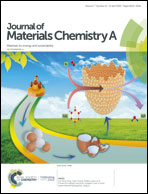The construction of self-supported thorny leaf-like nickel-cobalt bimetal phosphides as efficient bifunctional electrocatalysts for urea electrolysis†
Abstract
Urea electrolysis offers the prospect of cost-effective and energy-saving hydrogen production together with mitigating urea-rich wastewater pollution instead of overall water splitting. Hence, here, high-efficiency bifunctional electrocatalysts were developed for both the urea oxidation reaction (UOR) and hydrogen evolution reaction (HER) via the in situ vertical growth of thorny leaf-like (2D nanosheets supporting 1D nanowires) NiCoP on a carbon cloth (NiCoP/CC). After integrating the advantages of the synergistic effect between Ni and Co as well as the unique hierarchical structure combined with 1D nanowires, 2D nanosheets and a 3D conductive carbon cloth substrate, the electrode exhibited excellent electrocatalytic activity toward HER and UOR. The electrolytic cell assembled using NiCoP/CC as the anode and the cathode could provide current density of 10 mA cm−2 at a cell voltage of 1.42 V (160 mV less than that for its urea-free counterpart) as well as remarkable durability over 30 h. Thus, the cost-effectiveness and high activity of the NiCoP/CC electrode pave the way to explore transition metal-based electrocatalysts for urea electrolysis.



 Please wait while we load your content...
Please wait while we load your content...